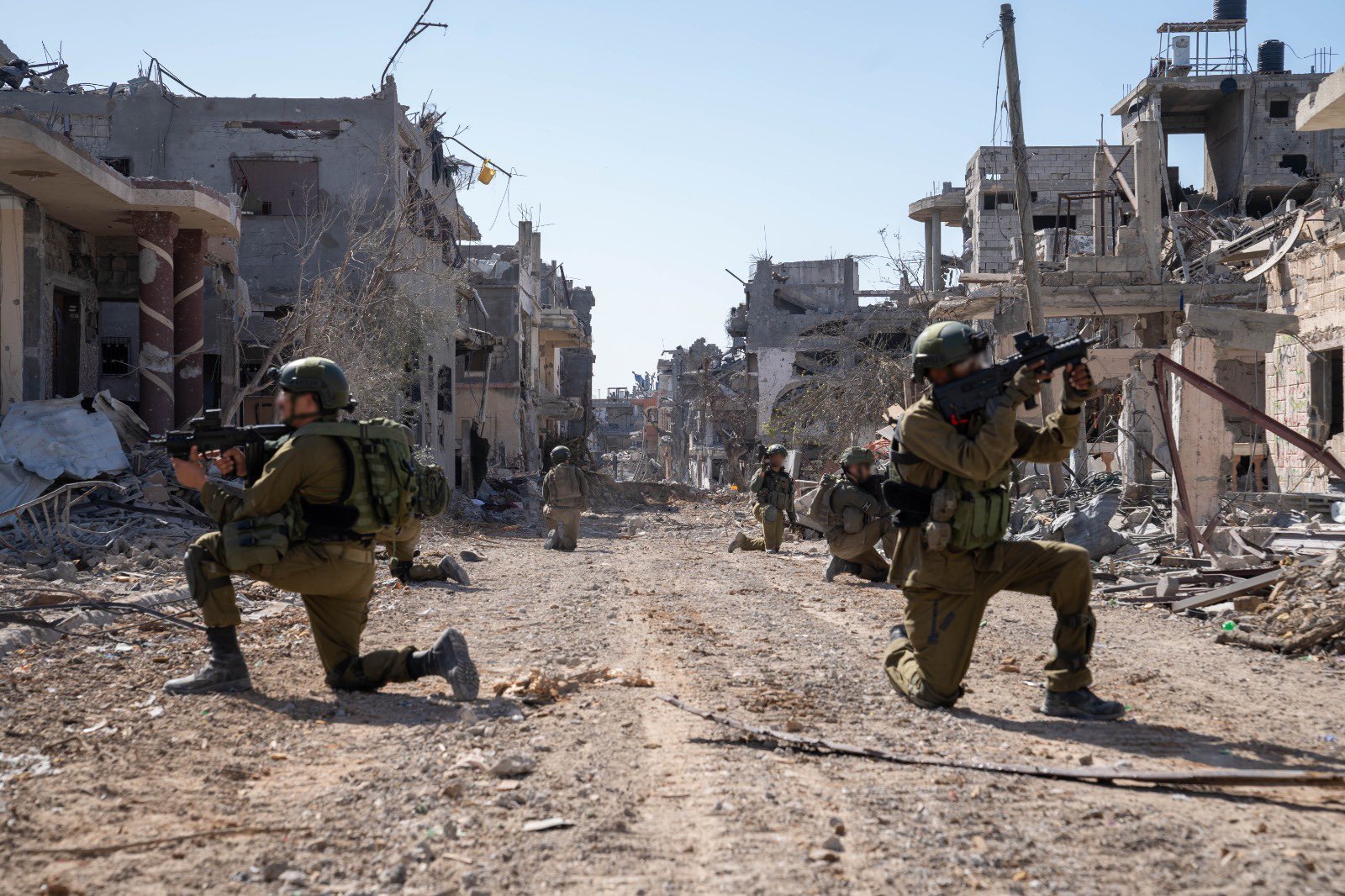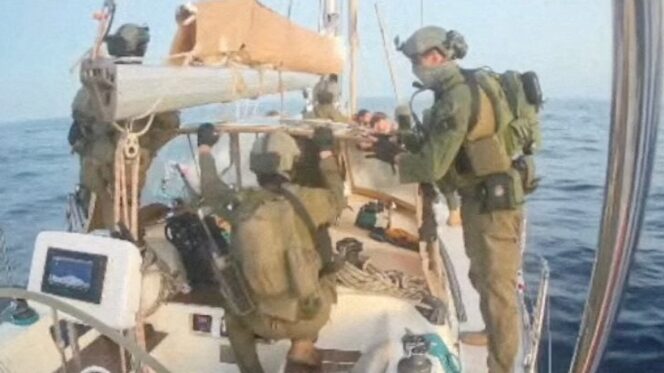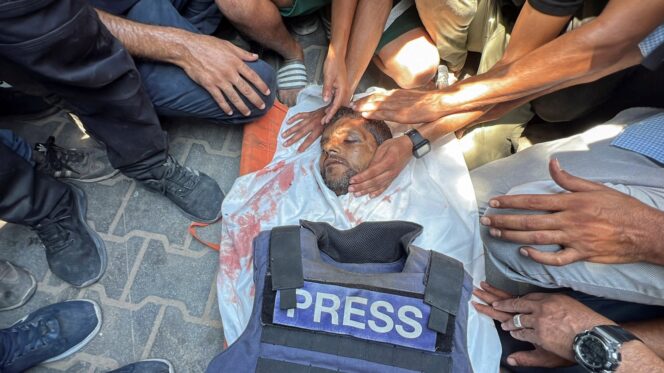The Israeli Military Strategies the BBC Doesn’t Want You to Know About
Don’t mention the Hannibal directive.
by Harriet Williamson
7 October 2025

Since 7 October 2023, Israel has waged a brutal war on Gaza. On conservative estimates, the country has killed at least 65,000 people and injured over 160,000 since then, reducing much of the 140 square-mile strip to a moonscape of rubble. In September, a UN commission found that Israel has committed genocide in Gaza.
At the heart of Israel’s actions are two key military strategies – the Dahiya doctrine and the Hannibal directive. Understanding these strategies is key to understanding Israel’s ongoing war on the occupied Palestinian territory, but you may not have even heard of them. That’s because for all the BBC’s coverage of the so-called Israel-Gaza war over the last two years, it’s failed to mention them.
In its June report on BBC bias, the Centre for Media Monitoring (CfMM) called this a “military doctrine blackout”, and described the BBC’s omission of key historical and contemporary context as “systemic” and having “acquired an institutional quality”.
Former BBC News journalist Mohamed Shalaby told Novara Media that the BBC failed to engage in “critical or meaningful journalism” after 7 October. When he pitched a specific story on 29 November 2023 about deaths due to the Hannibal directive – which originated from information already reported by Israeli media – it was never commissioned, but later other outlets ran the “same exact story”.
Shalaby said that journalists were unable to name specific IDF units or generals, even when they were implicated by journalistic fact-finding, and that any mention of Israel on the BBC had to be accompanied with a statement from the Israeli Defence Forces (IDF).
“This is what we mean when we [previous BBC employees] say we were forced to do PR for the IDF,” Shalaby said. “They are controlling our lines and we’re not allowed to actually practice proper journalism that holds the IDF to account.”
In a statement, the BBC said: “BBC News has reported and analysed [the] IDF’s strategy throughout the war, and has highlighted the Dahiya report and Hannibal directive in our coverage where we feel it appropriate in aiding the audiences’ understanding.”
The BBC said it’s standard for news outlets to include rights of replies as part of the Ofcom Broadcasting Code.
The BBC also called any suggestion of a military doctrine blackout “nonsense” and provided two examples to Novara Media – one BBC News article from 2016 that mentions the Dahiya doctrine and one from 2015 that mentions the Hannibal directive.
The BBC did not provide any evidence of reporting on either military strategy from October 2023 onwards.
Here’s what the BBC doesn’t want you to know about the Dahiya doctrine and the Hannibal directive.
What is the Dahiya doctrine?
The Dahiya doctrine is an Israeli military strategy involving the use of disproportionate force and the deliberate targeting of civilians and civilian infrastructure in order to put pressure on a hostile government or armed group. It provides the key to much of the IDF’s actions over the past two years in the Gaza Strip.
Most recently, it can be seen in the escalating bombardment of Gaza City, currently sheltering an estimated one million people. It is also where a man-made famine was recently declared due to Israel blocking food from entering Gaza.
Israel announced it had formally begun operations to take control of Gaza City in August. Since then, the IDF has decimated every essential system in the city, from hospitals and schools, to water infrastructure and residential homes.
Where did the Dahiya doctrine come from?
The Dahiya doctrine is named after the Dahiya suburb of Beirut in Lebanon, the location of political party and paramilitary group Hezbollah’s headquarters. A proscribed organisation in the UK, Hezbollah was born out of Israel’s invasion and occupation of southern Lebanon in the 1980s.
Over the next 20 years, Hezbollah existed to oppose the continued occupation of Lebanese territory and detention of Lebanese prisoners by Israel. In July 2006, things escalated when Hezbollah fighters fired rockets at Israeli military positions and border villages while another unit killed eight Israeli soldiers and captured two more.
Israel’s prime minister at the time promised a “very painful and far-reaching response”, which resulted in the 2006 Israel-Lebanon war, in which Israel killed over 1,000 civilians – around a third of them children.
The 33-day armed conflict saw Israel attack Lebanon by air, land and sea. According to the International Committee of the Red Cross, Israel’s air force flew more than 12,000 combat missions, its navy fired 2,500 shells, and its army fired over 100,000 shells, destroying large parts of Lebanon’s civilian infrastructure. This included Beirut airport, roads, bridges, ports, water and sewage treatment plants, electrical facilities, fuel stations, commercial structures, schools and hospitals, as well as private homes.
The Dahiya suburb was decimated. 30,000 homes were destroyed or damaged, and 900,000 people were displaced. Israel also sustained casualties, with 43 civilians killed, 997 injured and 300,000 people displaced.
In 2008, Israeli general Gadi Eisenkot said that what happened in Dahiya two years earlier would be repeated in every village deemed to pose a threat to Israel.
“We will apply disproportionate force… and cause great damage and destruction,” Eisenkot told the Yedioth Ahronoth newspaper. “From our standpoint, these are not civilian villages, they are military bases. This is not a recommendation. This is a plan. And it has been approved.”
The use of disproportionate force and the targeting of civilians and civilian infrastructure are recognised as war crimes under international law.
When has the Dahiya doctrine been used?
The Dahiya doctrine was enacted during Operation Cast Lead, also referred to as the Gaza war, the first Gaza war or the Gaza massacre, which began on 27 December 2008 and ended in a unilateral ceasefire on 18 January 2009. During the three-week operation, Israel killed 1,400 Palestinians and destroyed 46,000 homes, leaving over 100,000 people homeless.
A 2009 UN inquiry found that Operation Cast Lead was “a deliberately disproportionate attack designed to punish, humiliate and terrorise a civilian population”.
The Dahiya doctrine also came into play during Operation Protective Edge, known more widely as the 2014 Gaza war, which was launched on 7 July 2014 by Israel with the aim of stopping Hamas rocket-fire from the Gaza Strip. More than 2,000 Palestinians were killed, along with six Israeli civilians.
Operation Protective Edge destroyed entire neighbourhoods in Gaza, flattened high-rise residential buildings and targeted Gaza’s only power plant, leading to shortages of clean water and electricity, and raw sewage flowing through the streets.
After investigating four Israeli attacks in Operation Protective Edge, Human Rights Watch said the bombing of civilian structures “suggest[ed] illegal policy”, and found that the IDF “presented no information to show that it was attacking lawful military objectives or acted to minimize civilian casualties”. One attack on a municipal vehicle in the Bureij refugee camp resulted in the partial disembowelling of a nine-year-old girl who was sitting in front of her home.
The Dahiya doctrine is also on display in Israel’s ongoing genocide in Gaza. Since October 2023, Israel has reportedly attacked all 36 hospitals in Gaza, and used airstrikes, shelling, burning and controlled demolitions to damage or destroy over 90% of Gaza’s schools and university buildings.
According to the Israeli +972 Magazine, the vast destruction of residential buildings in Gaza has partly been implemented through an AI system called Habsora [the Gospel, in English], which generates hundreds of targets daily with reduced concern for civilian casualties as part of a deliberate strategy to exert pressure on Hamas through civilian suffering.
According to +972 sources, the use of AI-based systems like Habsora allows strikes to be carried out on homes on a huge scale, which “knowingly kill[s] entire families”. A former intelligence officer described the AI system as facilitating a “mass assassination factory”.
The IDF’s own datasets show that at least 83% of Palestinians killed in Gaza between October 2023 and May 2025 have been civilians.
What is the Hannibal directive?
The Hannibal directive – also known as the Hannibal procedure or Hannibal protocol – is an IDF command intended to prevent the kidnapping of Israeli soldiers by enemy forces by any means necessary. It involves the use of heavy fire to stop those attempting to abduct Israeli personnel, even when it may lead to the death or injury of those being taken or of non-Israeli civilians.
The directive has been used during Israeli operations over the past 25 years, but is particularly controversial due to its use during the 7 October attacks and Israel’s subsequent assault on Gaza.
Speaking about the directive, Asa Kasher – author of the IDF’s code of ethics – said: “During Operation Cast Lead, I heard commanding officers say, ‘None of our men will be kidnapped. That doesn’t just mean be careful. It means kill yourself rather than let it happen’.”
Why was the Hannibal directive created?
Introduced in 1986, the Hannibal directive was the Israeli military’s attempt to reduce the number of abductions of their soldiers after two were captured in a Hezbollah ambush in south Lebanon.
It also followed backlash to the Jibril agreement – an agreement made with the Popular Front for the Liberation of Palestine when Israel began pulling out of Lebanon after its June 1982 invasion. The Jibril agreement meant that three Israeli soldiers would be released in exchange for the freedom of 1,150 Palestinians held in Israeli jails.
The Hannibal directive was drawn up by three senior military officers in the Northern Command HQ – Major-General Yossi Peled, Colonel Gabi Ashkenazi, and Colonel Yaakov Amidror.
It ordered every possible action to be taken to avert a soldier being kidnapped – including firing at the kidnappers and risking the lives of hostages.
Israeli newspaper Maariv reported a section of the directive in 2014: “During a hijacking, the primary mission becomes rescuing our soldiers from the hands of the kidnappers, even at the cost of harming or injuring our soldiers.
“If the kidnappers and the kidnapped are identified and do not respond to calls to stop, small arms fire must be used in order to bring the kidnappers to the ground or arrest them.
“If the vehicle or the kidnappers do not stop, small arms fire must be fired at them in a single, deliberate manner, in order to harm the kidnappers, even if it means harming our soldiers.”
The final point was accompanied by an asterisk and the words: “In any case, everything will be done to stop the vehicle and prevent its escape.”
When has the Hannibal directive been used?
There are many instances of the Hannibal directive being invoked or allegedly invoked, starting with the Hezbollah capture of three Israeli soldiers in the Israeli-occupied Shebaa Farms in October 2000. It resulted in IDF attack helicopters firing at 26 moving vehicles in the area on the assumption that the abducted soldiers were transported in one of them.
The father of one abducted soldier said he’d heard about the directive before his son was kidnapped. “I visited him in the army and he told me about the procedure,” he said. “He told me that the order was that if a group of soldiers was abducted, the vehicle had to be stopped at any price, even if this cost the soldiers’ lives. I was appalled. I asked him if he would be willing to shoot at his buddies. He said it was an order.”
Another use of the directive was during Operation Protective Edge. It was deployed in Rafah following the abduction of junior Israeli officer Lieutenant Hadar Goldin. A joint investigation by Forensic Architecture and Amnesty International into the massacre that followed – known as Black Friday – concluded that the directive had been deployed, leading to the deaths of around 200 Palestinian civilians, including 75 children.
Eyewitnesses described fire from F-16 jets, drones, helicopters and artillery raining down on the streets with no warning, saying it was like “a machine making mincemeat out of people without mercy”.
The IDF later denied the directive had been enacted, although it did admit it had been repeatedly referenced over radio comms.
Of the Black Friday massacre, Amnesty’s Middle East and North Africa director Philip Luther said: “After Lieutenant Hadar Goldin was captured, Israeli forces appear to have thrown out the rule book, employing a ‘gloves off’ policy with devastating consequences for civilians. The goal was to foil his capture at any cost.”
Israeli newspaper Haaretz reported in July 2024 that the IDF enacted the Hannibal directive multiple times when Hamas militants attacked southern Israel on 7 October 2023. The first instance was when reports came in that a kidnapping had taken place at the Erez border crossing. The command from the divisional headquarters was “Hannibal at Erez… dispatch a Zik [unmanned assault drone]”.
Haaretz did not estimate the number of civilians and soldiers hit, but says data indicates that “many” of those kidnapped were exposed to Israeli gunfire “even if they were not the target”.
Former Israeli officer air force Colonel Nof Erez told a Haaretz podcast the directive was not specifically ordered but was “apparently applied” by aircrews, calling 7 October “a mass Hannibal” event.
A Haaretz editorial from January 2024 also called on the IDF to investigate an Israeli tank firing two mortar shells at a home in Kibbutz Be’eri with 14 Israeli hostages inside on 7 October. The allegation is based on the testimony of the only two Israeli survivors of the incident.
Former BBC News journalist Mohamed Shalaby told Novara Media: “I was able to geolocate and find the house [in Kibbutz Be’eri], and I pitched that story. There were actually testimonies of young IDF reserve soldiers saying how their commanders told them: ‘Just open fire and don’t care’.” Shalaby’s BBC editors didn’t want the story.
‘Grotesque omission’.
The existence of the Hannibal directive remained an Israeli military secret for many years – and western media organisations remain hesitant about mentioning its existence even today.
On 7 October 2023, 1,195 people were reportedly killed in the Hamas attacks – 736 Israeli civilians including 38 children, 79 foreign nationals and 379 members of the Israeli security forces. The BBC has consistently presented these deaths as attributable to Hamas fighters, denying its audience context or a proper investigation into how many of them were killed by Israeli military fire in a “mass Hannibal event”.
When questioned as to why the BBC had made the “grotesque omission” of not mentioning or explaining either the Hannibal directive or the Dahiya doctrine in its post-7 October coverage by journalist Peter Oborne in June, BBC News’ director of news content Richard Burgess said he wasn’t familiar with them.
The BBC told Novara Media: “The BBC has repeatedly called on Israel to allow independent media access into Gaza so it can report on the ground and share the burden with Palestinian journalists.”
Harriet Williamson is a commissioning editor and reporter for Novara Media.


